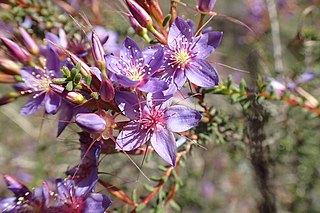
Calytrix acutifolia is a species of flowering plant in the myrtle family Myrtaceae and is endemic to south-west of Western Australia. It is a slender, openly-branched shrub with linear to lance-shaped leaves and clusters of white, cream-coloured or yellow flowers with 40 to 85 white stamens in several rows.
Calytrix ecalycata is a species of flowering plant in the myrtle family Myrtaceae and is endemic to the south-west of Western Australia. It is a slender, erect shrub with linear to narrowly elliptic leaves, and yellow flowers with 35 to 50 stamens in several rows.
Calytrix gypsophila, commonly known as gypsum fringle-myrtle, is a species of flowering plant in the myrtle family Myrtaceae and is endemic to southern continental Australia. It is a glabrous shrub with oblong, linear or lance-shaped leaves with the narrower end towards the base, and white flowers with 25 to 40 stamens in a single row.
Calytrix habrantha is a species of flowering plant in the myrtle family Myrtaceae and is endemic to Western Australia. It is a glabrous shrub with linear leaves and magenta to rich pink flowers with about 25 to 35 stamens in several rows.
Calytrix paucicostata is a species of flowering plant in the myrtle family Myrtaceae and is endemic to a restricted area in the west of Western Australia. It is a shrub with linear leaves and bright to rich pink flowers with about 75 to 88 stamens in several rows.
Calytrix platycheiridia is a species of flowering plant in the myrtle family Myrtaceae and is endemic to a restricted area in the south-west of Western Australia. It is a shrub with egg-shaped leaves and cream-coloured flowers with about 35 to 50 yellow stamens in several rows.

Calytrix praecipua is a species of flowering plant in the myrtle family Myrtaceae and is endemic to inland areas of Western Australia. It is a shrub with decussate leaves and pink to pinkish-white flowers with about 21 to 27 stamens in a single row.

Calytrix violacea is a species of flowering plant in the myrtle family, Myrtaceae and is endemic to the southwest of Western Australia. It is a shrub with linear to narrowly egg-shaped leaves with the narrower end towards the base, and purple, star-shaped flowers.
Calytrix patrickiae is a species of flowering plant in the myrtle family Myrtaceae and is endemic to a restricted area in the south-west of Western Australia. It is a spreading shrub with many branches, decussate, egg-shaped to narrowly oblong leaves and deep purple flowers with a yellow base, and about 30 to 40 stamens in several rows.

Calytrix pimeleoides is a species of flowering plant in the myrtle family Myrtaceae and is endemic to the west of Western Australia. It is an erect shrub with overlapping narrowly elliptic to egg-shaped leaves with the narrower end towards the base and yellow flowers with 35 to 50 stamens in several rows.
Calytrix pulchella is a species of flowering plant in the myrtle family Myrtaceae and is endemic to the south-west of Western Australia. It is a glabrous shrub with widely spaced, linear to narrowly elliptic leaves and purple flowers, with about 40 to 50 stamens in several rows.
Hypocalymma verticillare is a species of flowering plant in the myrtle family Myrtaceae, and is endemic to the south-west of Western Australia. It is a shrub, with egg-shaped to elliptic leaves, and white flowers with 17 to 23 stamens.
Micromyrtus uniovulum is a species of flowering plant in the family Myrtaceae and is endemic to a small area in the south-west of Western Australia. It is a low, spreading, sometimes erect shrub with oblong leaves, and white flowers with 10 stamens.

Babingtonia cherticola is a species of flowering plant in the family Myrtaceae and is endemic to the southwest of Western Australia. It is an erect shrub with linear leaves and white or pale pink flowers in groups of up to three, each flower with 16 to 26 stamens.
Babingtonia fascifolia is a species of flowering plant in the family Myrtaceae and is endemic to the southwest of Western Australia. It is a shrub with erect, slender stems, linear leaves and white or pale pink flowers in groups two to seven in leaf axils, each flower with 19 to 23 stamens.
Babingtonia triandra, commonly known as triplet babingtonia, is a species of flowering plant in the family Myrtaceae and is endemic to a restricted area of the southwest of Western Australia. It is a low, spreading to almost prostrate shrub with linear leaves and white flowers usually arranged in groups of up to 16 in leaf axils, each flower with 3 widely spaced stamens.
Calytrix cravenii is a species of flowering plant in the myrtle family Myrtaceae and is endemic to the south-west of Western Australia. It is an erect, open shrub with linear leaves and clusters of white flowers with 18 to 29 white stamens in several rows.
Calytrix gomphrenoides is a species of flowering plant in the myrtle family Myrtaceae and is endemic to the Kimberley region of Western Australia. It is a glabrous, multi-stemmed shrub with linear leaves and white flowers turning pink as they age, with 16 to 18 stamens in a single row.

Calytrix hirta is a species of flowering plant in the myrtle family Myrtaceae and is endemic to the south-west of Western Australia. It is a spreading shrub with linear to slightly curved leaves and clusters of white flowers with 32 to 46 white stamens in several rows.
Calytrix hislopii is a species of flowering plant in the myrtle family Myrtaceae and is endemic to inland regions of Western Australia. It has been described as a "squat, gnarled sub shrub" with narrowly elliptic to linear leaves and yellow flowers with about 25 to 40 stamens in several rows.





